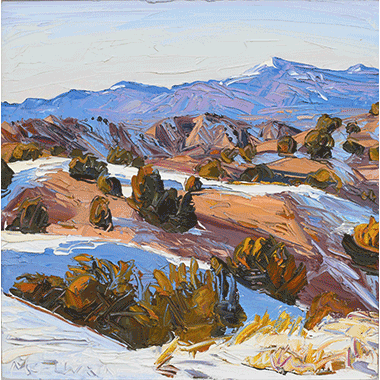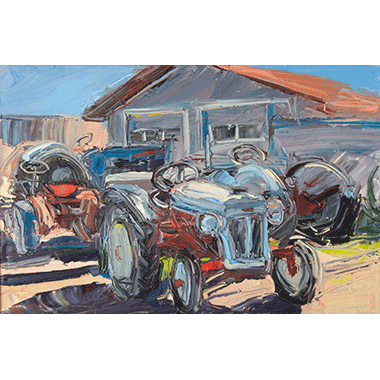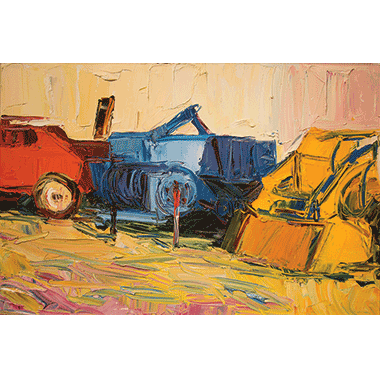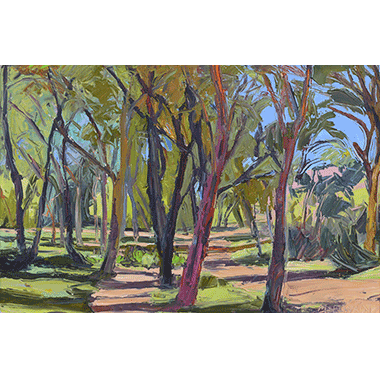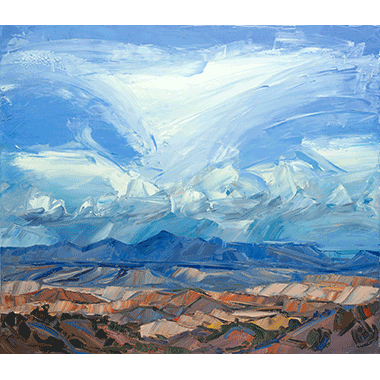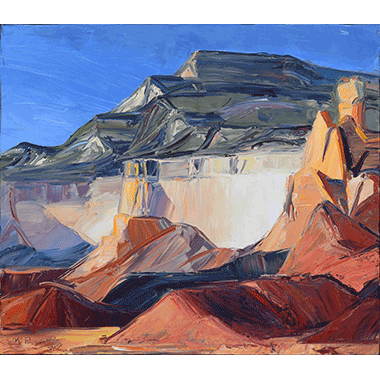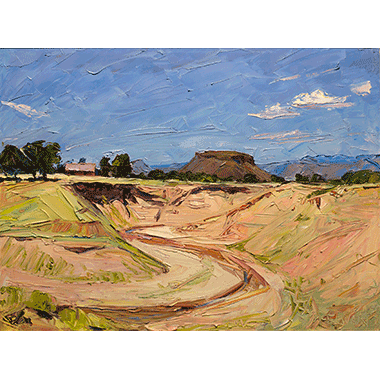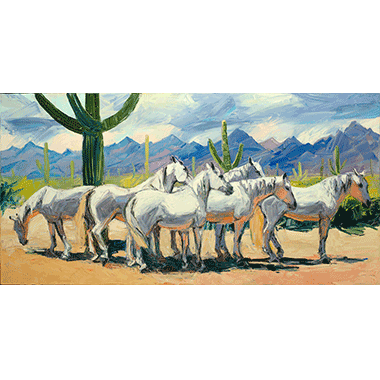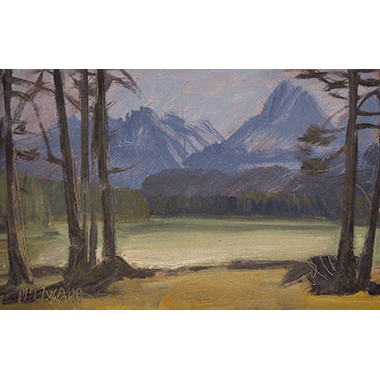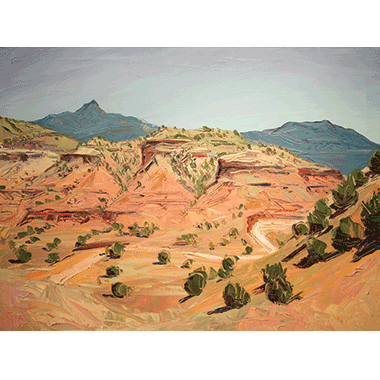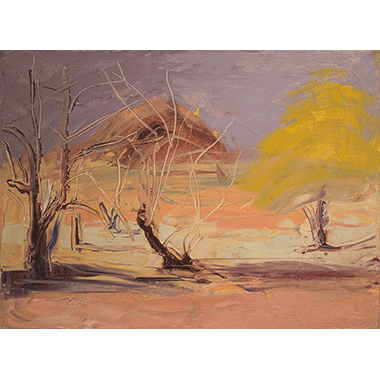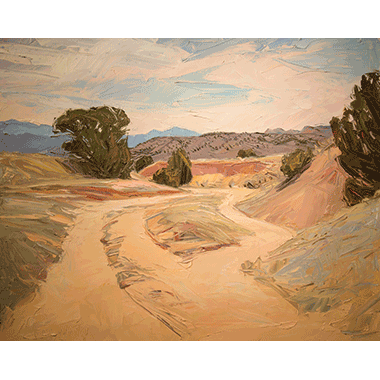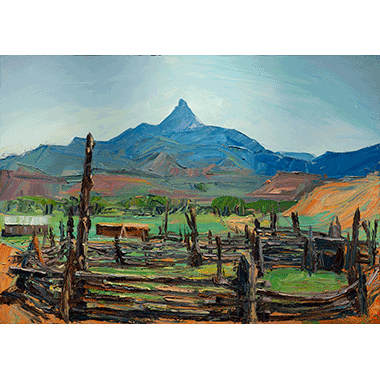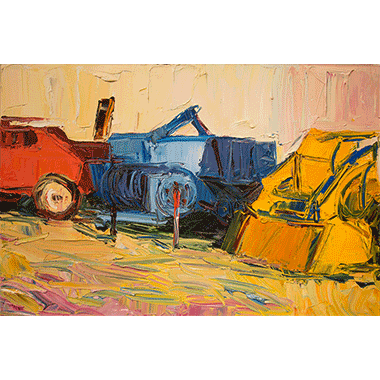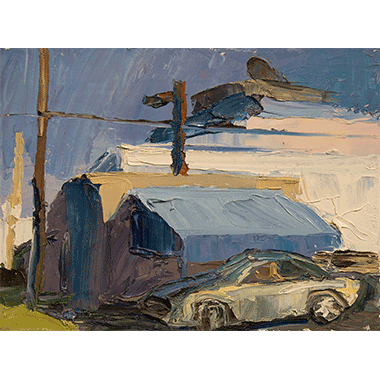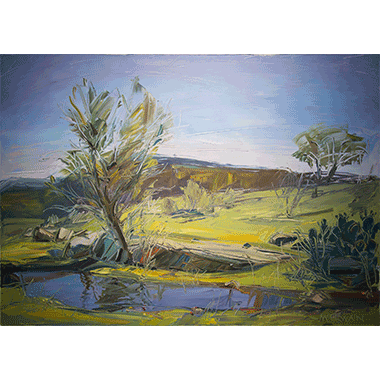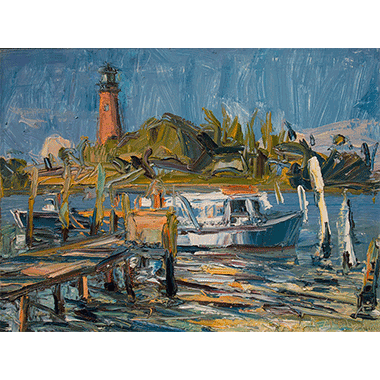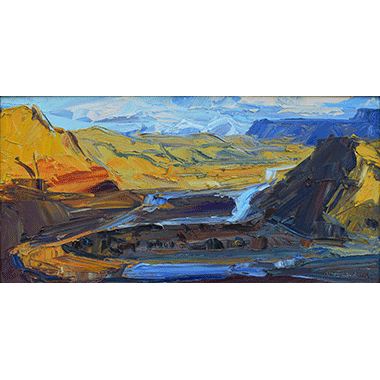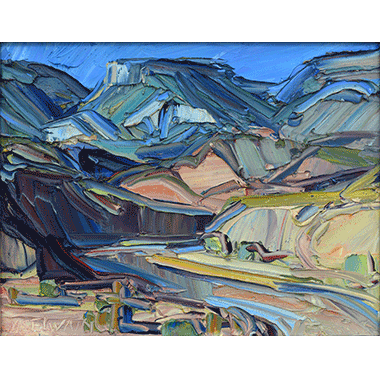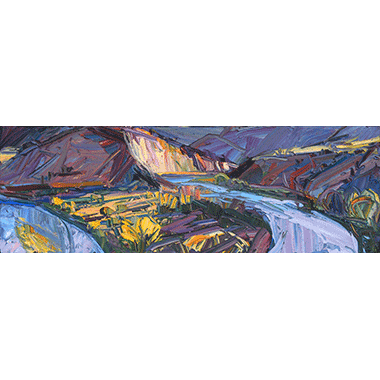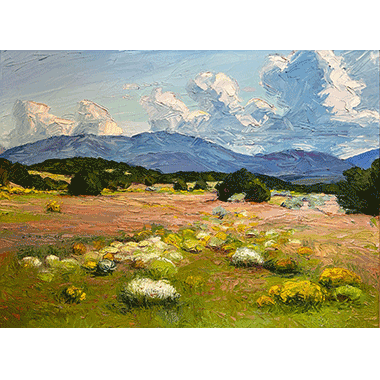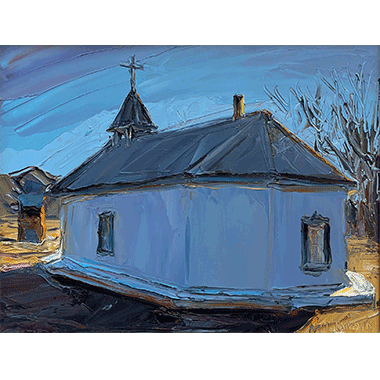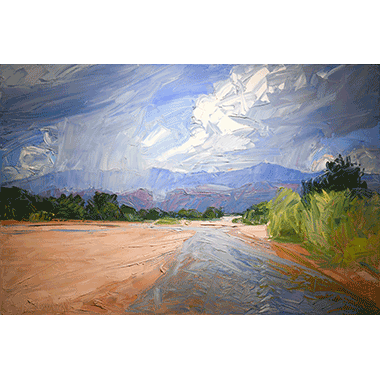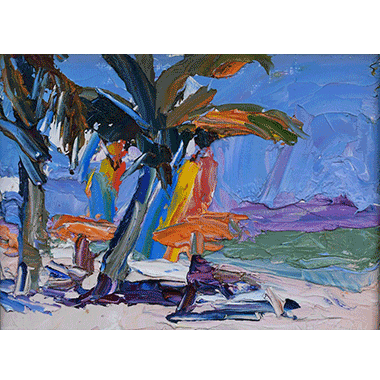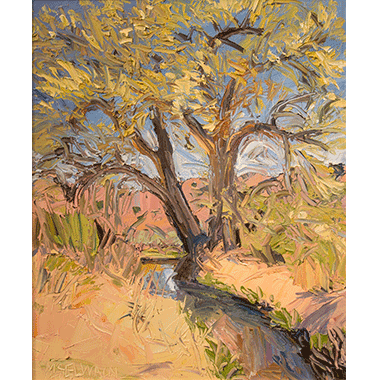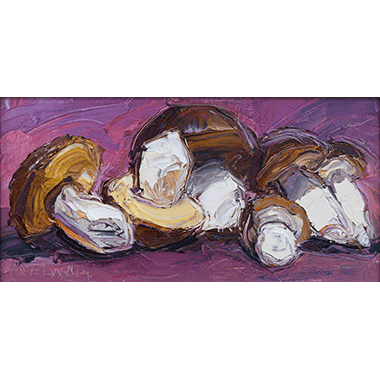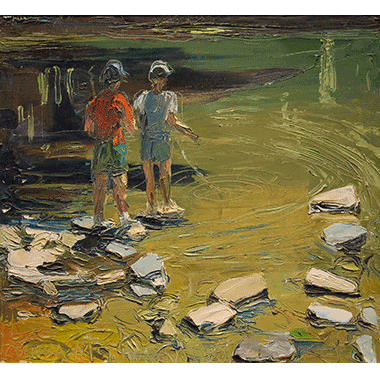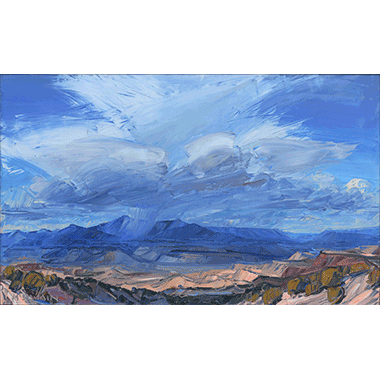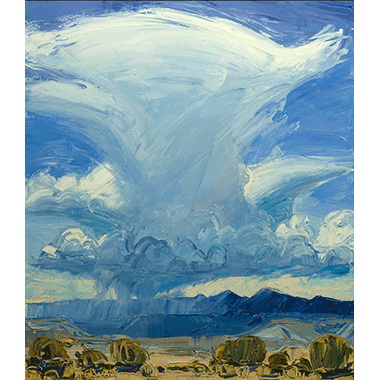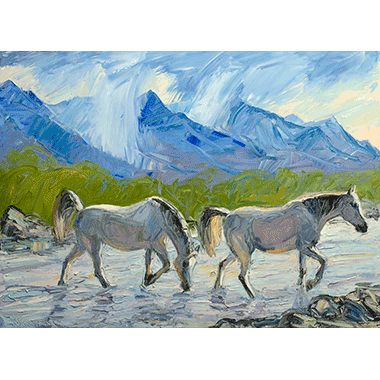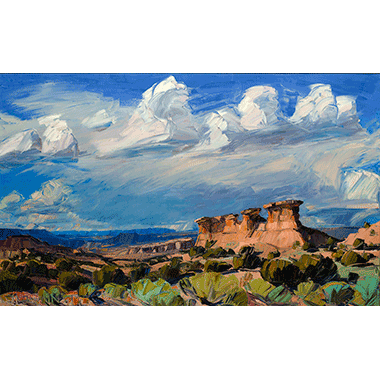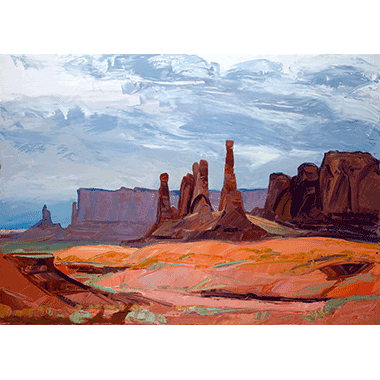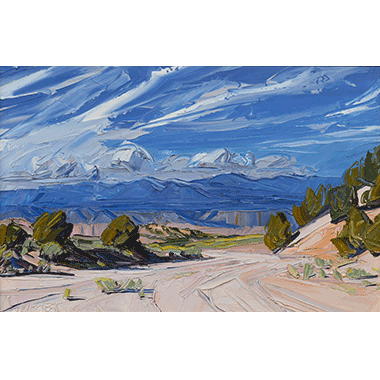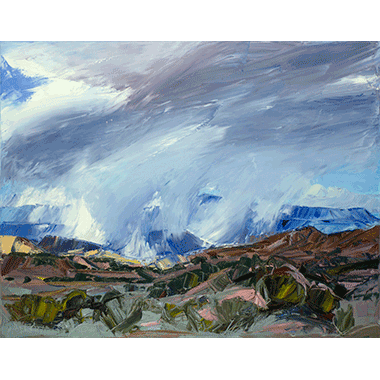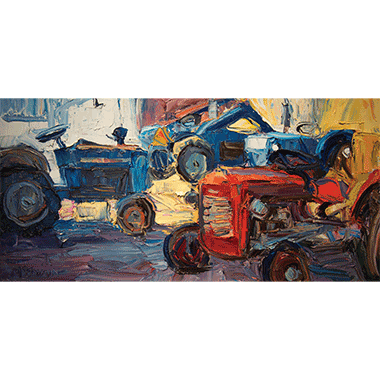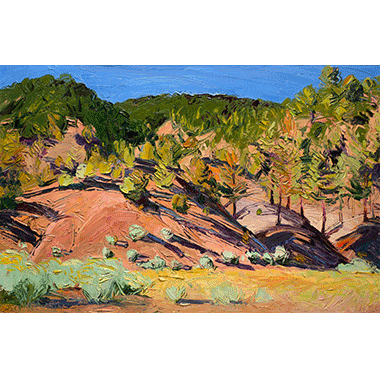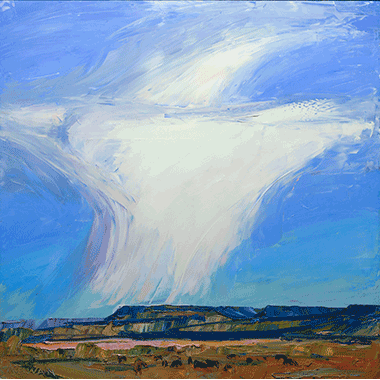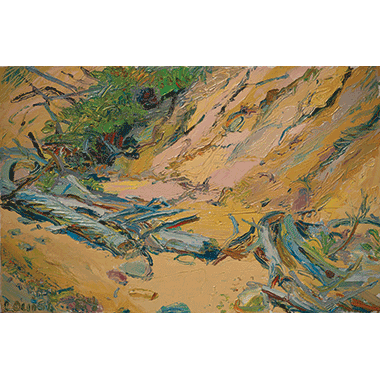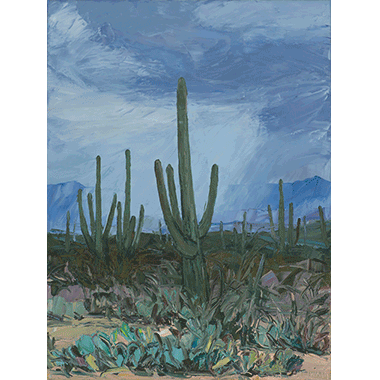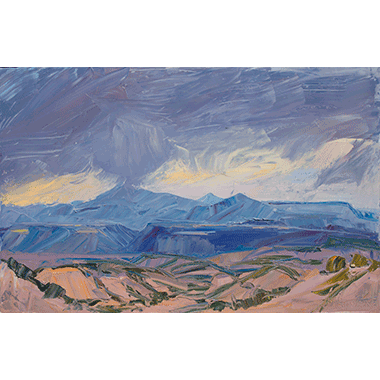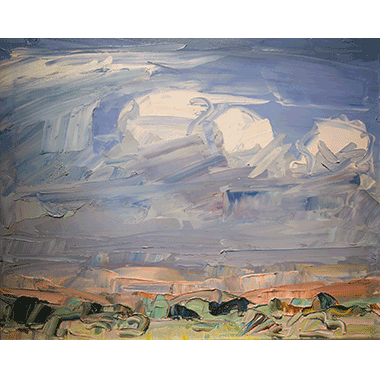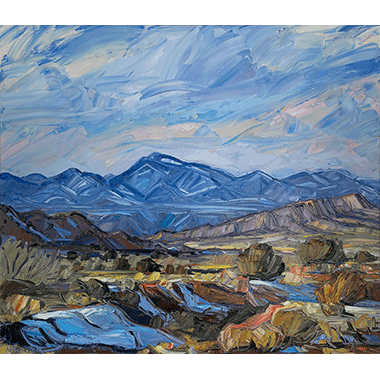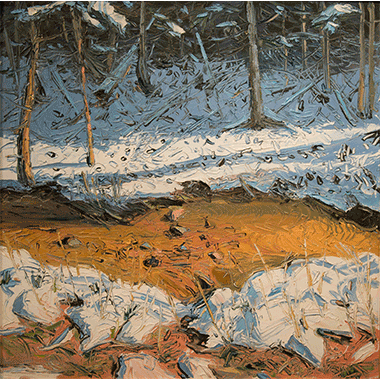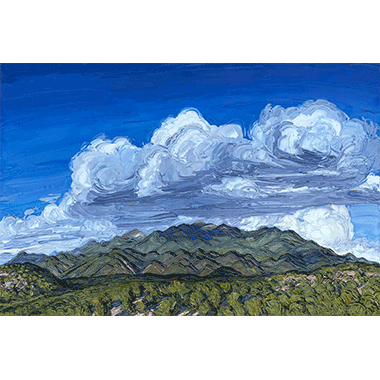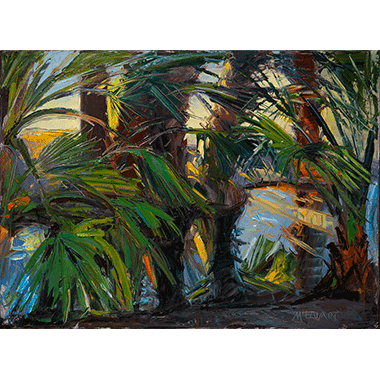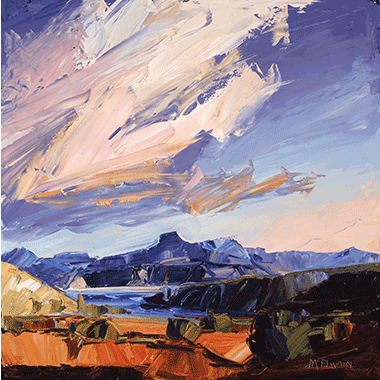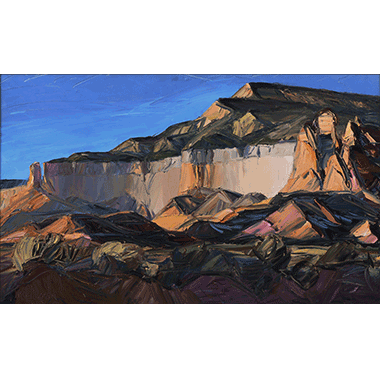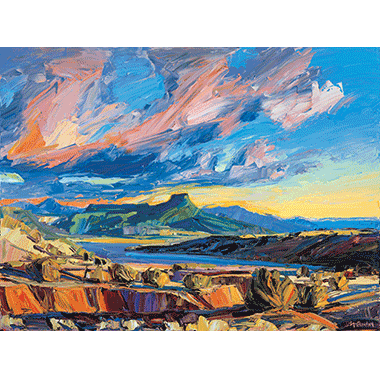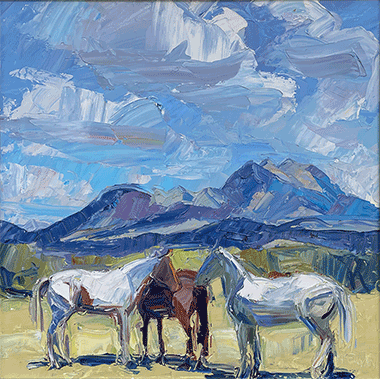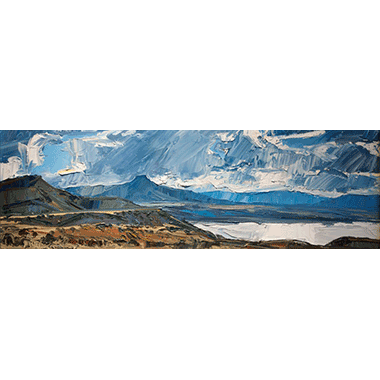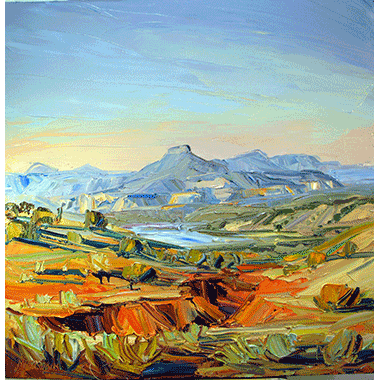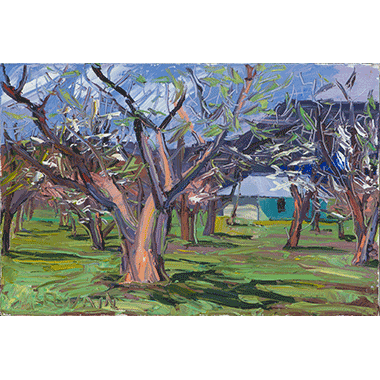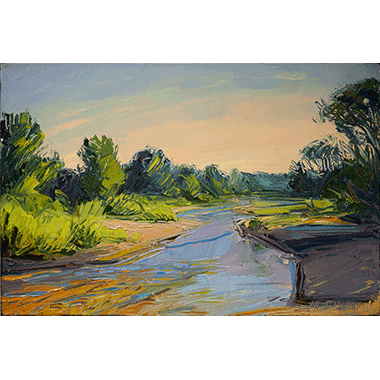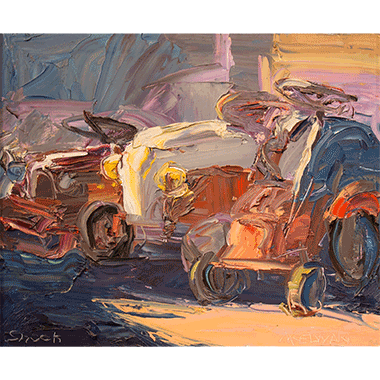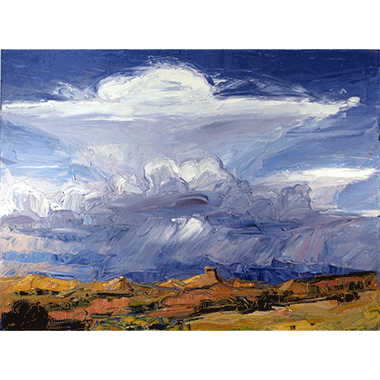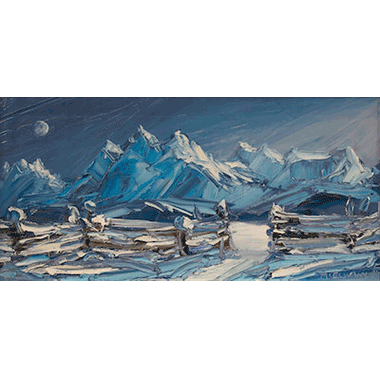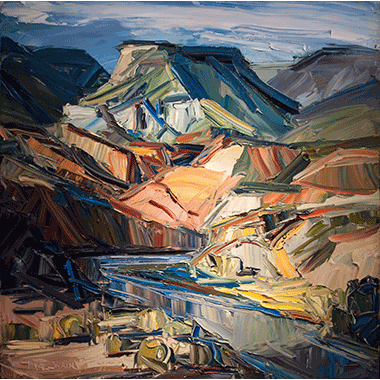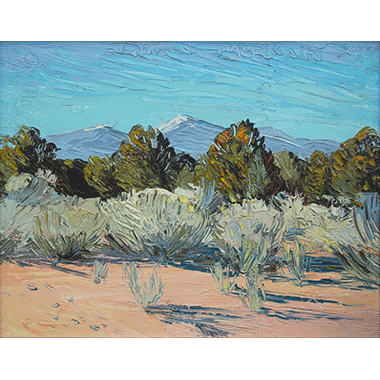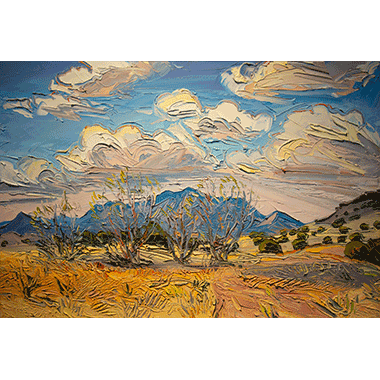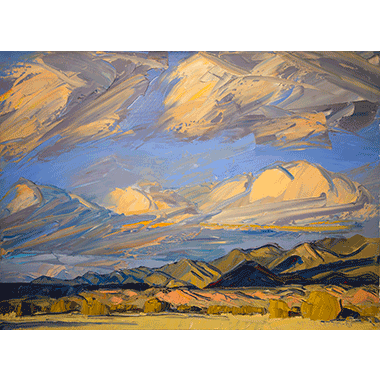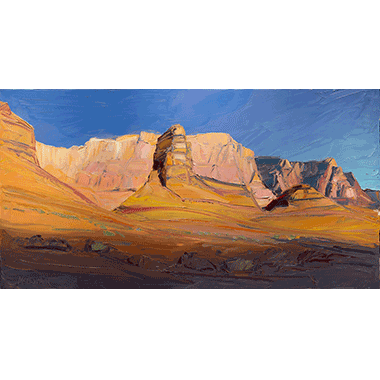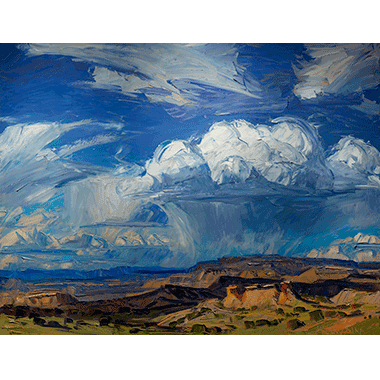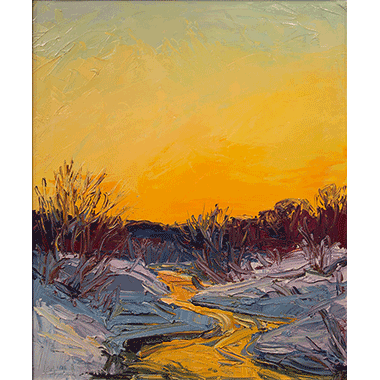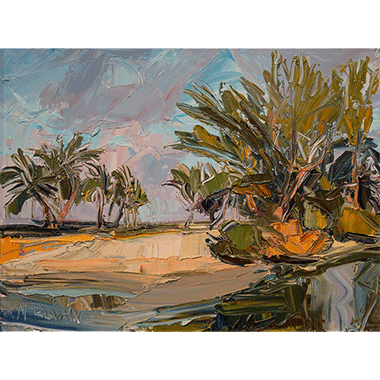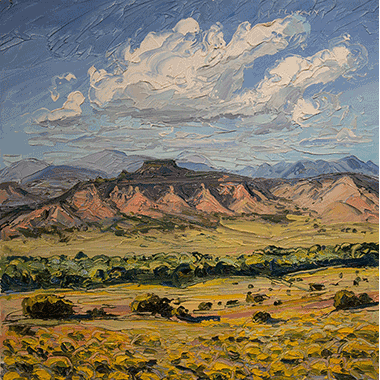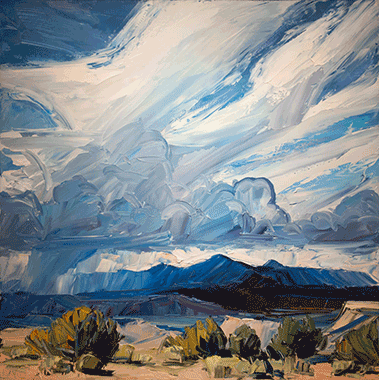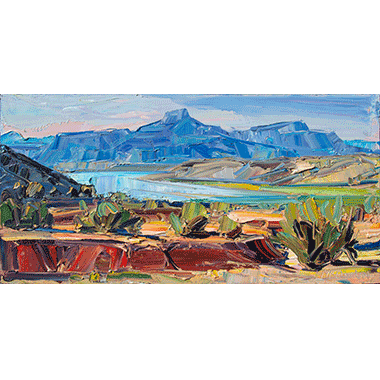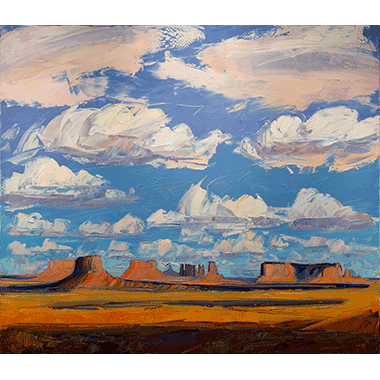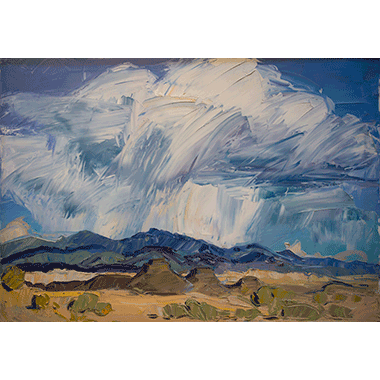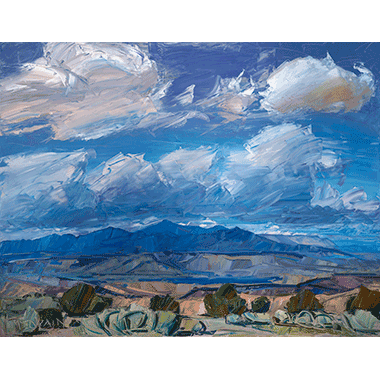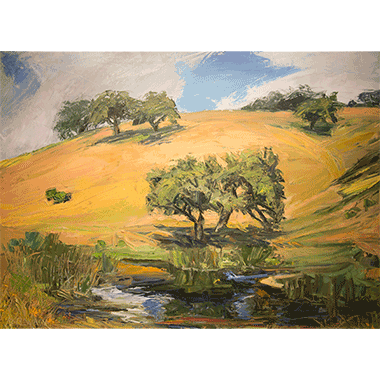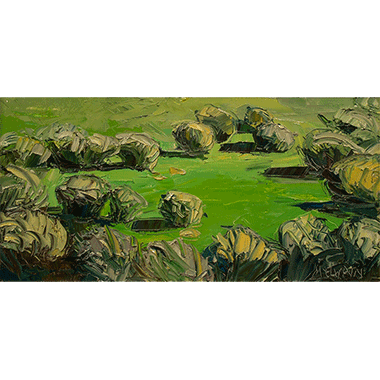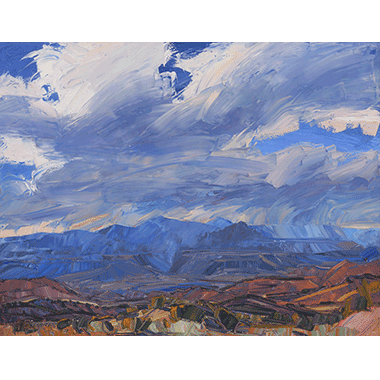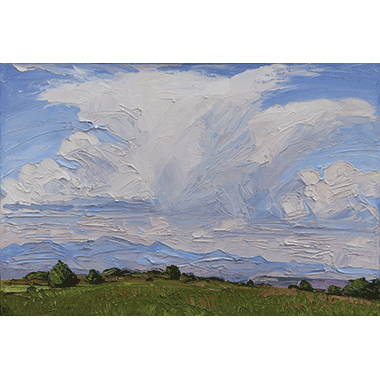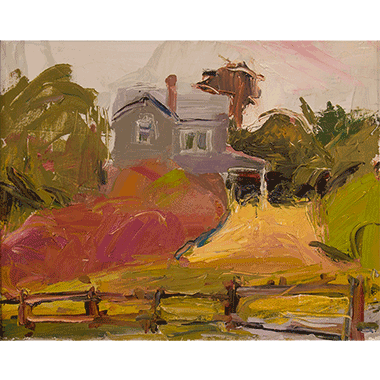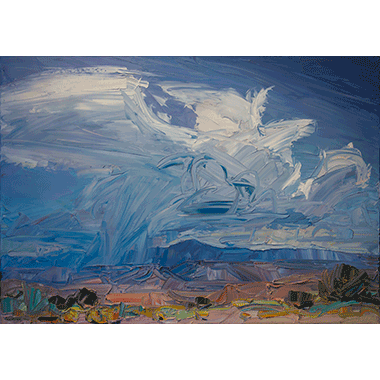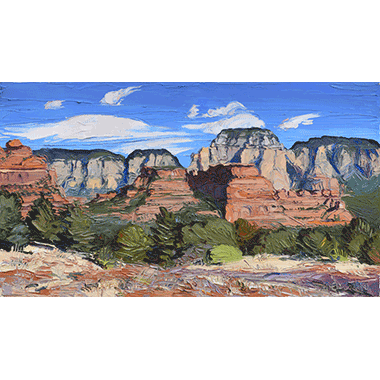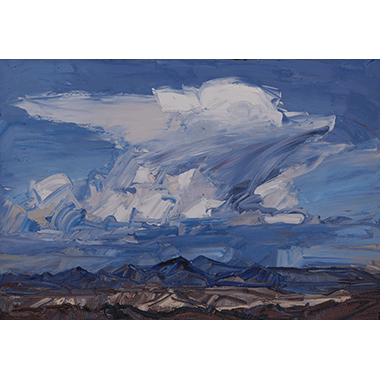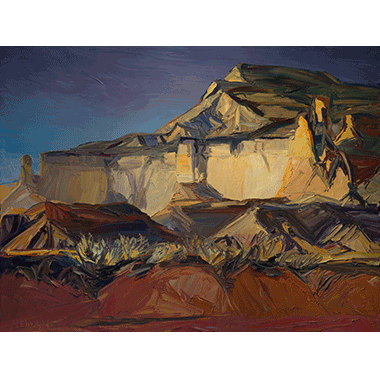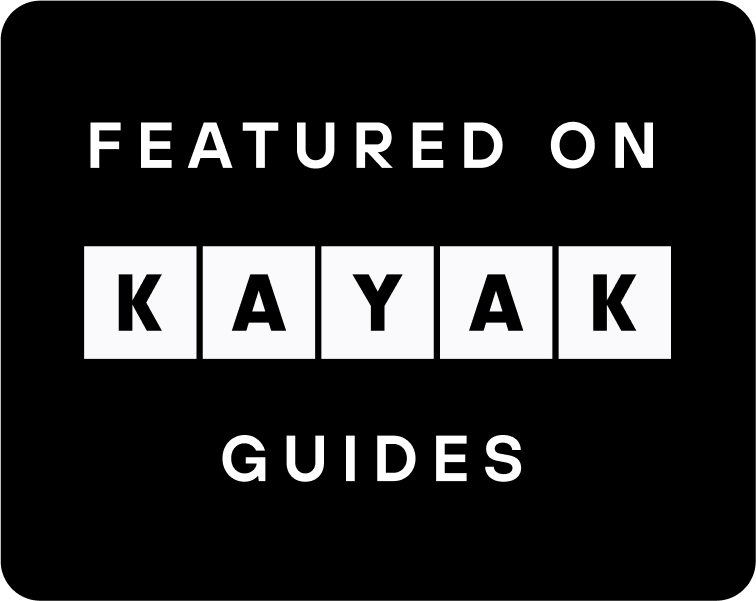LOUISA MCELWAIN
We accept Louisa McElwain consignments
Please call 505.995.9902, or email us for details Email
Representing the Estate of:
Louisa McElwain 1953–2013
Louisa McElwain adored summer storms, especially the way the light changes and the clouds dance across the horizon ahead of the rain. Living in the country, 20 miles outside of Santa Fe, New Mexico, Louisa was in tune with the changing weather. If it looked like “one of those days,” she was quick to pack up her pick-up truck and head out to find that “power spot” for what she liked to call “a dialogue with nature.” Once there, she moved quickly, stapling a large canvas to a makeshift armature mounted on the back of the pick-up. The tailgate provided a table for all of her paint — large globs squeezed in strict order from dozens of tubes. With palette knives and masonry trowels of all sizes, including some attached with duck tape to long sticks, she would go to work.
Louisa was always looking for a balance between her experience with the environment and the physical reality of paint on canvas. She believed “the marks, strokes and gestures of paint express forces of nature, both internal and external.” Jackson Pollock once famously said, “I am nature.” ...
(continued)
... That resonated with Louisa who believed that this idea of working from the inside out while honoring the rhythms of nature, was the most important contribution offered by 20th century American painters in the Abstract Expressionist Movement. The approach freed many artists who rejected the rigid plein-air approach. “My painterly heritage is the New York School,” says Louisa. “I am an abstract painter who paints outside.” And for Louisa, the act of creating was a workout — she called it “extreme painting.” “I often feel energy, like electricity, surging upward from the ground, through my knees, through my arms and right on to the canvas.”
Looking at a Louisa McElwain painting today, the importance of color is clear. Bold strokes of thick paint cut across the canvas forming a collage of colorful shapes that meld together into an abstracted landscape. Louisa wasn’t interested in realism. “I like painting with sticks (palette knives) because it disengages my ego — that part of me that wants to be about describing things. I do like to draw and I do like to be right, but when I’m making a painting I want it to be as much about the paint as the motif. The palette knife doesn’t allow me to articulate things in a drawing way, but it does have an additional dimension of expressing the sensuous quality of paint. It expresses more of the physicality of the material than I’m likely to achieve with a brush.” But what came so naturally in later years, wasn’t always inherent. Louisa learned about color from some of the best teachers of the time.
After her studies in Europe with master portrait artist, Nera Simi, Louisa attended a summer session at the Skowhegan School in Maine. She spent an eye-opening three months working with Alex Katz and famed landscape painter Neil Welliver. “It was paradise for painters and sculptors. We had little cottages on the lake, and up on the hill old dairy barns had been turned into great studio space. For those of us who wanted to go out and paint landscapes, the kitchen would make a bag lunch and we’d jump in the back of a pick-up truck. Maine is so broad-shouldered and open — great things to see and paint. It was a wonderful experience.” Skowhegan was life changing for McElwain. She left Maine committed to landscape painting. “Alex Katz once told me, ‘You have to find your way to say the grass,’ which I took as a mandate. A sacred duty of every artist to originality.” And she never wavered from that commitment. Another crucial part of Louisa’s artistic education came from Joseph Albers by way of Welliver, at the University of Pennsylvania, where Louisa finished up her undergraduate degree. Albers, the famed color theorist, championed the idea that color is always seen in relation to the colors around it. At Penn, where he was a professor, Welliver applied those color principles to his own work, and Louisa was paying attention. “Albers was almost scientific in his approach to color,” she says. “He reduced color in nature to some very dynamic and simplified relationships of flat pieces of color — each piece of paint has its own identity. It’s almost like the pre-digital pixalization of color. Instead of having a tonal structure, a painting is built on the relationship of colors. I came to understand how light is created through the relationship of color.”
“I have lived and painted in New Mexico since 1985, working outdoors under a wide variety of conditions, open to the impulse of changing light, wind, heat, cold, insects, forces of Nature which bring life into my paintings. For me, painting is a dance to the tempo of the evolving day. Usually, I paint off the back of a pick-up truck, which gives me access to many wonderful places, and provides a way to stabilize and transport large canvases. Here in the West it seems that the canvas is never big enough. To include my entire field of vision at arm's length, 60 x 90 inches is about right. I paint with knives and masonry trowels, which allow me to work fast. Each painting is completed in less than 4 hours, regardless of size, as permitted by weather and light. Painting large canvases outdoors invites another interaction with Nature as, inevitably, insects, particles of plants and soil end up on the painting. I see these as valuable contributions to the work. Sometimes I put little stones, bones or pieces of glass and plants into the paint, in the same spirit as the Navajo weaver who incorporates things into her blanket to bless those who will receive it, and as a way of acknowledging the temporality of things. My process is an inquiry into sensuous potential of paint. To explore the mystery of sensation, to touch that which is known but cannot be measured, understood yet indescribable; the act of painting is an expression of my connectedness with God and Nature. I am Nature.”
Louisa McElwain
Louisa McElwain selected awards and honors
Art of the National Parks: Historic Connections, Contemporary Interpretations, book release, 2013
Durango Arts Center Four Corners Commission Exposition, First Place, 2012
Phoenix Art Museum, West Select, Phoenix, AZ, 2011
Desert Caballeros Western Museum, Cowgirl Up, Museum Purchase Award, Wickenberg, AZ, 2010
National Cowgirl Museum and Hall of Fame, 6th Annual Heart of the West Exhibition, Best of Show, Fort Worth, TX, 2010
Desert Caballeros Western Museum, Cowgirl Up, Best of Show, Wickenberg, AZ, 2010
"Landscapes of New Mexico" book release, Santa Fe, NM, 2006
Louisa McElwain selected collections
American Embassy, Bogota, Columbia
American Embassy, Manama, Bahrain
American Embassy, Sanaa, Yemen
American Embassy, Singapore
AT&T, Fresno, CA
Coors Brewing Co, Golden, CO
INA Corp. Harrisburg, PA
NATO Headquarters, Brussels, Belgium
Nokia, Irving, TX
Peat Marwick, San Francisco, CA
Pepsi-Cola, Riverside, CA
Philadelphia Zoological Society, Philadelphia, PA
Phoenix Art Museum, Phoenix, AZ
Rosewoods Vineyards, Redwood Valley, CA
San Juan College, Farmington, NM
St. Vincent Hospital Foundation, Santa Fe, NM
The Booth Museum, Cartersville, GA
Tia Collection, Santa Fe, NM
Tucson Museum of Art, Tucson, AZ
University of Pennsylvania, Philadelphia, PA
University of Texas Law School, Austin, TX
Louisa McElwain education
1990 Santa Fe Institute of Fine Arts, NM Master Class with Wolf Kahn
1977 BFA, University of Pennsylvania, Philadelphia, PA
1975 Skowhegan School of Painting and Sculpture, Skowhegan, ME
1973–1974 Tyler School of Art, Philadelphia, PA
1973 Nera Simi Drawing Studio, Florence, Italy
1971 Hampshire College, Amherst, MA
1971 Mount Holyoke College, sculpture with Leonard De Longa
2024
Looking and Seeing. Louisa McElwain: Fanfare, John O’Hern
2022
Evokation. Artist Spotlight - Oil of Joy: Louisa McElwain, Elizabeth L. Delaney
2021
Forbes. Louisa McElwain’s Joy Lives On Through Breathtaking New Mexico Landscapes, Chad Scott
Western Art and Architecture. Perspective Louisa McElwain [1953-2013], Gussie Fauntleroy
2020
Evoke Contemporary Catalogue. A Dialogue with Nature: Paintings by Louisa McElwain. Essay by Christopher Benson
2017
Southwest Art. Show Preview: Louisa McElwain
Fine Art Connoisseur. Great Art, Great Friends. Andrew Webster
2016
PleinAir Magazine: Outdoor Painter. Exhibition: Louisa McElwain in Santa Fe
2013
Art of the National Parks: Historic Connections, Contemporary Interpretations. Jean Stern, Susan Hallsten McGarry, Terry Lawson Dunn
2012
Art, Food and Home. Featured Artist… Louisa McElwain, Barbara Stroud
Western Art and Architecture. Exuberance of Spirit. Gussie Fauntleroy
2010
Artists Network. Landscape Painting: A Southwest Plein Air Demonstration
2009
Phoenix Art Museum. Artists: Louisa McElwain
2006
Landscapes of New Mexico: Paintings in the Land of Enchantment. Suzan Campbell, Curator with Suzanne Deats. Fresco Fine Art Publications, LLC, Albuquerque, NM
2000
Southwest Art. Louisa McElwain: A Life in Full, Gussie Fauntleroy
Others:
A Dialogue With Nature. Essay by Christopher Benson. Evoke Contemporary Publications
Distant Thunder. Introduction by Jerry N. Smith, PhD. Evoke Contemporary Publications
Videos:
Louisa McElwain Artist Profile Film. Directed by Carlo Zanella
InsideArt: Louisa McElwain. Directed by John Carver































